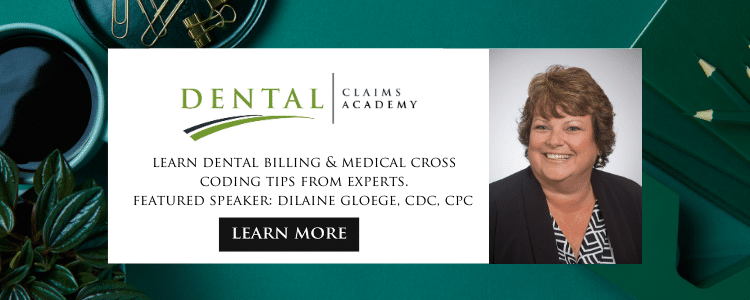Dental Terminology Cheatsheet: What You Need To Know


Who wouldn't love a dental terminology cheat sheet? You went to school to be a dentist, and your specialty lies in helping patients achieve exceptional oral health—not figuring out dental claim terminology. We get that, so when it comes to all things dental insurance, Dental Cashflow Solutions is here to help. As an outsourced dental billing partner, we work with hundreds of practices across the country to help them focus on getting paid by eliminating the strain of dealing with insurance companies.
Because of this, we know it is important to have a basic understanding of certain key terms in the dental billing world for a successful billing department within your business. Not understanding these terms can create stress when addressing concerns about insurance and payments with patients.
This article will help you understand the basic terms you should know so that you can get back to helping patients achieve optimal oral health. First, you will learn the most important dental billing terms that dental teams must know. This will help you understand how to discuss any kind of concern you may have when dealing with insurance.
Then, you will learn types of insurance plans you will see in the industry and how they determine the actual payment. Following a review of the essential terms, is the classifications of plan benefits. Knowing each classification defines how much each type of procedure is covered by insurance and how much you will get paid per procedure. By the end of this article you will know how to use all of this information to your advantage.
Essential Dental Billing Terms to Know
- Deductible: A set amount of money a patient pays out-of-pocket for dental expenses before the insurance company pays the plan’s benefits. Most plans include a yearly deductible per person and a family deductible.
- Coinsurance: Coinsurance means that the patient and their dental plan each pay a fixed percentage of the total dental bill or plan maximum allowance. This is sometimes referred to as cost sharing. Cost sharing is generally after a deductible is met, when applicable.
- Pre-Existing Condition: A term used in many medical fields, pre-existing condition refers to any dental condition that existed prior to enrolling in an insurance plan, even if the condition has been formally diagnosed. For the dental industry, the most common pre-existing condition is a missing tooth clause.
- Allowable Amount: An Allowable Amount refers to the highest price for services covered by an insurance company.
- Allowable Charge: The Allowable Charge is the maximum amount that a patient pays for services.
- Denied: Means the plan will not pay for the service, however, the patient is responsible for the charge.
- Non-billable to the Patient: Means that the plan will not pay for the service and the patient cannot be billed for the service. This applies only to PPO contract provisions.
- Balance Billing: The ability to bill the patient for any remaining amount up to the full fee submitted on the dental claim. Applies to out-of-network plans with some exceptions that may apply to PPO plans.
- Contracted Fee/Negotiated Fee: The fee agreement between a provider and a PPO contract.
What Types of Dental Plans Do Patients Present?
- Preferred Provider Organization (PPO): A Preferred Provider Organization enters into a contract with a dental provider to participate in a network. The PPO contract includes a negotiated fee agreement and other provisions. The negotiated fee agreement is the amount per procedure that determines the patient financial responsibility.
For the patient, selecting an in-network provider for dental care reduces their out-of-pocket expense. Patients with a PPO plan have access to the network of dentists/providers. - Exclusive Provider Organization (EPO): An EPO is a plan in which the patient has no out of network benefits.
- Discount Plan: A dental plan purchased by the patient directly from the insurance company that offers discount fees for specific procedures when rendered by a participating dentist. No claim is filed, the applicable discount is given to the patient. The provider signs an agreement agreeing to honor the discounted fee schedule for the plan.
- Dental Health Maintenance Organization (DHMO): A patient with a DHMO plan is assigned a dentist and will only receive benefits when treatment is rendered by the assigned dentist. The dentist agrees to accept a monthly fee for each patient assigned in exchange for providing dental care. A claim is submitted, however it is submitted using a specific encounter form, not the ADA dental claim form. The patient has a low out-of-pocket cost for this type of plan.
- Fully-insured/Indemnity Plan: The insurance company pays a percentage of a maximum allowable charge. The patient pays any amount the plan does not pay, up to the full fee for the service. These plans are also referred to as “fee for service” plans. The indemnity plan is an individual or small group plan purchased directly from the payer. An indemnity plan may also be a PPO plan where the patient can elect to receive dental treatment from an in-network dentist, reducing their out-of-pocket costs. A fully-insured plan falls under the jurisdiction of the insurance commissioner of the state in which the plan originated and follows that state’s insurance laws.
- Self-funded Plan: A self-funded plan is one in which the employer is 100% at risk for all claims paid. The self-funded plan may hire an insurance payer to administer their plan, known as a third-party administrator (TPA). The TPA may also provide a network, such as a PPO network of dentists, to help lower the cost of providing benefits not only to the patient out-of-pocket but also for the employer since all benefits paid belong to the employer. A self-funded plan does not fall under the jurisdiction of any state insurance commissioner nor is this type of plan required to follow state insurance laws. A self-funded plan follows Employee Retirement Insurance Security Act (ERISA), which is federal law.
- Federal Plan: Federal dental benefits can be confusing. There is TRICARE®, FEDVIP, and FEDHB, to name a few. Federal plans follow federal laws, not state insurance laws. The provisions and processes established in each plan document dictates how claims are paid and the process to be followed. Always ask the federal employee for their medical and dental card as many patients have embedded dental benefits in their federal health plan, unbeknownst to them. Not all patients elect to enroll in the federal health benefit plan but many have. The federal health benefit plan will always be primary to any FEDVIP dental benefit plans so that is why it is highly recommended that the practice ask for both medical and dental cards.
Classifications of Dental Plan Benefits
Each plan determines a percentage paid for each type of procedure. These are referred to as a class of benefits. This is plan specific and may differ from our examples below:
- Preventive Services: This class (class A or I) includes routine procedures, such as dental cleanings, diagnostic x-rays and other preventive procedures.
- Most plans will pay for preventive services at 100% of the plan allowable. If in-network then the plan will pay 100% of the PPO contracted fee. The dentist will then make a PPO fee adjustment, known as the write-off.
- If the dentist is out-of-network then the plan will pay 100% of the Usual and Customary (UCR) fee, as determined by the plan (i.e., office fee is $100, plan pays 100% of the $80 UCR fee. The out-of-network patient is billed for any remaining balance up to the full fee charged.
- Basic Services: Common examples in this class (class B or II) include fillings and simple extractions. Many plans include root canal therapy in the basic class of benefits, but not all so it is important to verify benefits prior to providing treatment. Most plans pay basic services at 80% of the plan allowable (UCR of the plan or PPO contracted fee). Some plans, specifically indemnity plans, will include a waiting period for basic services with the most common waiting period being 6 months from the effective date of coverage.
- Major Services: As the name suggests, (class C or III) are procedures more “major” in nature such as: bridges, crowns, root canals, or oral surgery. Most plans pay major services at 50% of the plan allowable (UCR of the plan or PPO contracted fee). Many plans, specifically indemnity plans, will include a waiting period with the most common waiting period being 12 months from the effective date of coverage.
Using Dental Billing Terms to Your Advantage
Now that you are familiar with the basic terminology of dental billing, what is the next step? How can you utilize this newfound knowledge to your advantage?
Dental Cashflow Solutions has informative webinars that can educate you on how understanding these terms will help you in your day-to-day life in a dental office. Webinars are offered covering an array of topics.
We know the common dental billing issues that plague most offices. Understanding the billing process is the first step to preventing these issues. Our experts are passionate about helping you avoid the nuisances of dental insurance billing. Engaging in dental billing outsourcing services will increase your production, maximize profitability, and alleviate unwanted headaches.
Related Posts
Dental revenue resources from Dental Claim Support


